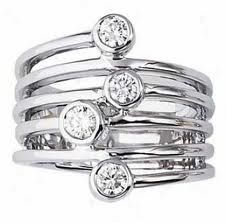As jewelry fashion trends go, white gold is HOT. Yellow gold is still fashionable, but white gold has even overtaken the wedding market, surpassing platinum as the “silver” ring of choice. Have you ever wondered what makes white gold…well, white? Did it start out that way from the ground, is it manufactured, or just plain yellow gold that is coated with a white metal? Read on for the answer.
In its natural state, gold is a very soft, very yellow metal. All newly discovered gold is 24 karat, its purest form. But in this state, its softness makes it too soft and unreliable for every day wear. In the U.S., we like our gold harder. Then our investment can stand the test of time and retain its original beauty far longer than if it was made of a purer form of gold.
To enhance the strength and durability of gold, other metals are then mixed with it. Knowing this, you can probably guess that the lower the gold content, the more other metals are mixed in.
So, back to our question, “What is ‘white gold’?”
White gold is yellow gold mixed often with palladium, silver and less frequently nickel. Nickel has fallen out of favor as a white gold additive because it can cause an allergic reaction over long-term wear. While the reactions are generally mild (a slight rash) most people don’t buy jewelry to have their skin react badly.
While mixing these metals together creates a much less yellow hue, the actual color of white gold is closer to gray. The bright white luster of white gold comes from a coating of rhodium, another complementary metal. Rhodium gives white gold its brilliance, sheen and highly reflective appearance. However, this coating does wear off over time, and the piece must be recoated to retain its original luster.
White gold may be all the rage, but not everyone agrees they look good with it on. Personally, I’m a blonde and yellow gold is much more complimentary to my coloring. I think I’ll stick with yellow gold. How about you?

